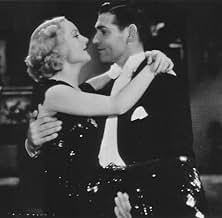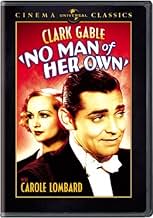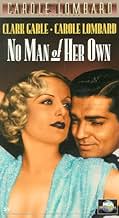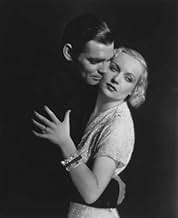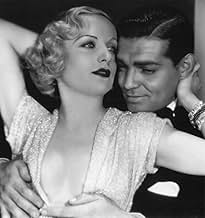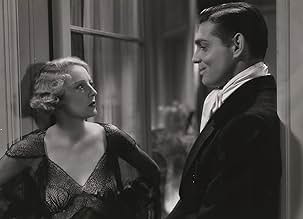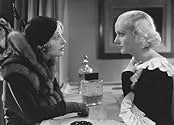VALUTAZIONE IMDb
6,6/10
1773
LA TUA VALUTAZIONE
Aggiungi una trama nella tua linguaAn on-the-lam New York card shark marries a small-town librarian who thinks he's a businessman.An on-the-lam New York card shark marries a small-town librarian who thinks he's a businessman.An on-the-lam New York card shark marries a small-town librarian who thinks he's a businessman.
- Regia
- Sceneggiatura
- Star
- Premi
- 1 vittoria in totale
Sammy Blum
- Door to Door Salesman
- (non citato nei titoli originali)
Mary Bracken
- High School Girl
- (non citato nei titoli originali)
Wallis Clark
- Thomas Laidlaw
- (non citato nei titoli originali)
Lillian Harmer
- Mattie
- (non citato nei titoli originali)
Margaret Marquis
- Girl in the Library
- (non citato nei titoli originali)
Recensioni in evidenza
Recently my favorite video store acquired this movie on DVD, and I was very hopeful in renting it. As I am a huge fan of William Powell and Carole Lombard in "My Man Godfrey," I was astonished to hear the line "See you in church," dropped casually by Lombard in the middle of this film. That line, of course, appears early on in "My Man Godfrey."
I had always thought that this was a comic device, used for that particular film, but apparently it was something of comic parlance in the 1930s. After all, there is a four year spread between this film and "My Man Godfrey". If it still has resonance now, it must have been doubly meaningful to audiences then.
The plot itself is really thin, with Gable's character "Babe" deciding to marry Lombard's "Connie" on the flip of a coin. I don't know whether that was supposed to be THE COMIC DEVICE of the film or whether it was a throw-away notion coming from the screenwriters. It really doesn't matter much because it ruined the whole notion of the film, which is that Gable's "Babe" doesn't want any attachments of any kind to interfere with his life as a card sharp and cheat.
In the social history context, it is very interesting to see a film which shows men of wealth and status in New York City -- in the third year of the great Depression ( counting 1930, '31, and '32 as the epicenter of that disastrous time ) -- casually gambling away sums of money that would easily have sustained a family of four over an entire year !!
Lombard is an intriguing personality in the history of the American cinema and every one of her performances in the '30s speaks volumes about the genius she had contained within herself. She is so wistfully beautiful and her comic timing is usually impeccable. In this film she plays a woman who thinks she is wasting away in her small town, bored with her "unsteady" boyfriend and bored with her job as a librarian. The point is, however, that she was a young woman with a job in the depths of a depression that savaged the whole of the U.S. economy.
For audiences of that era, her character's decision to toss that safety and security for an "instant marriage" to the rogue "Babe" would have been both scandalous and highly romantic. The fact that Gable's very nefarious alternative lifestyle -- as a card sharp and con man -- nets him a plush apartment and plenty of ready money, doubles the scandalous nature of the plot. The fact that he and his confederates fleece the social class known as "New York Swells" accounts for some of the film's popularity in that time and in that era.
But Gable's "Babe" is not some Robin Hood type in a tuxedo. He and his partners cheat the rich and keep the money for themselves.
They are not progressives, they are not "reformers," they are crooks.
This enjoyable film earns a 5 from me for the supporting cast of actors and from Lombard's extraordinary ease of performance. The plot itself is so near to being utter nonsense that only her luminous and magnetic beauty saves the day for the entire ensemble. Clark Gable was the "good guy" with heartburn in "It Happened One Night," which is a far, far superior film. Here, he is just flat out all criminal with heartburn and no better than the bankers of that day, who foreclosed on homes and farms with nary a thought to the long-term consequences to their customers, to society, or to the health of the country which made them so prosperous to begin with. Seventy-five years later, these nuances are probably lost on people who don't know a lot about our true American history. The formulaic "happy ending" tells me that the producers ran out of story before the actors ran out of charisma or talent.
I had always thought that this was a comic device, used for that particular film, but apparently it was something of comic parlance in the 1930s. After all, there is a four year spread between this film and "My Man Godfrey". If it still has resonance now, it must have been doubly meaningful to audiences then.
The plot itself is really thin, with Gable's character "Babe" deciding to marry Lombard's "Connie" on the flip of a coin. I don't know whether that was supposed to be THE COMIC DEVICE of the film or whether it was a throw-away notion coming from the screenwriters. It really doesn't matter much because it ruined the whole notion of the film, which is that Gable's "Babe" doesn't want any attachments of any kind to interfere with his life as a card sharp and cheat.
In the social history context, it is very interesting to see a film which shows men of wealth and status in New York City -- in the third year of the great Depression ( counting 1930, '31, and '32 as the epicenter of that disastrous time ) -- casually gambling away sums of money that would easily have sustained a family of four over an entire year !!
Lombard is an intriguing personality in the history of the American cinema and every one of her performances in the '30s speaks volumes about the genius she had contained within herself. She is so wistfully beautiful and her comic timing is usually impeccable. In this film she plays a woman who thinks she is wasting away in her small town, bored with her "unsteady" boyfriend and bored with her job as a librarian. The point is, however, that she was a young woman with a job in the depths of a depression that savaged the whole of the U.S. economy.
For audiences of that era, her character's decision to toss that safety and security for an "instant marriage" to the rogue "Babe" would have been both scandalous and highly romantic. The fact that Gable's very nefarious alternative lifestyle -- as a card sharp and con man -- nets him a plush apartment and plenty of ready money, doubles the scandalous nature of the plot. The fact that he and his confederates fleece the social class known as "New York Swells" accounts for some of the film's popularity in that time and in that era.
But Gable's "Babe" is not some Robin Hood type in a tuxedo. He and his partners cheat the rich and keep the money for themselves.
They are not progressives, they are not "reformers," they are crooks.
This enjoyable film earns a 5 from me for the supporting cast of actors and from Lombard's extraordinary ease of performance. The plot itself is so near to being utter nonsense that only her luminous and magnetic beauty saves the day for the entire ensemble. Clark Gable was the "good guy" with heartburn in "It Happened One Night," which is a far, far superior film. Here, he is just flat out all criminal with heartburn and no better than the bankers of that day, who foreclosed on homes and farms with nary a thought to the long-term consequences to their customers, to society, or to the health of the country which made them so prosperous to begin with. Seventy-five years later, these nuances are probably lost on people who don't know a lot about our true American history. The formulaic "happy ending" tells me that the producers ran out of story before the actors ran out of charisma or talent.
The perks of this movie are many: a fun screwball comedy set-up involving card-sharking, two beautiful stars looking young and fantastic (you'll see why women first fell in love with Clarke Gable, and found him ideal to play Rhett Butler), the only on screen pairing of said stars, who were to become husband and wife. He would love her long after she died in a tragic plane accident on a mission to sell war bonds (i think it was). Another perk is the pre-production code raunchiness. You may notice that any movie made between 1930-1934 seems a lot racier than movies made before or after then. This is because in this short period there was no censorship of movie content, and no rules to say what you could and could not show on screen. This was left to the filmmaker's discretion. So you'll find shots of Gable in the shower, and Lombard also, though she is much less exposed. Not actual nudity, of course, but open sexiness banished from movies from 1934 till whenever the Hayes code ended - such as Gable asking Lombard the librarian to fetch him a book from the top shelf so she has to climb up the ladder and he can look at her legs.
If you've never seen a screwball comedy, you might be pleasantly surprised. They're all pretty fun. Bringing up Baby with Cary Grant and Katherine Hepburn is probably the best one. They were all the rage in the 30's, and Carole Lombard was the ideal screwball heroine. To be recommended.
If you've never seen a screwball comedy, you might be pleasantly surprised. They're all pretty fun. Bringing up Baby with Cary Grant and Katherine Hepburn is probably the best one. They were all the rage in the 30's, and Carole Lombard was the ideal screwball heroine. To be recommended.
I think other reviewers heard that this was supposed to be "a screwball comedy" and ran with that idea because they didn't know what else to say. I didn't see anything light and fluffy or "screwball" about it. Perhaps "offbeat" might be a more apt characterization. Gable's interpretation of the New York gambler was interesting because something in his usual sort of charming yet manly approach was notably lacking. He possessed the irreverent and utterly confident attitude we have come to associate with his other performances, but a number of his youthful facial expressions were of a more complex and unfamiliar sort. The reserved yet knowing way he nodded howdy-do upon introduction to Lombard's mother and then her father was especially amusing, I thought. There were also the many intriguing interactions with the actress, herself, particularly with regard to the touchy subjects of marriage and stability. The oft-subtle writing in this flick made for several interesting moments and both actors were fully up to the challenge of a sensitive and intelligent interpretation of the script. It is also interesting that there was allegedly no actual romantic attachment between these two because the chemistry was already quite evident. It must have miffed a number of the more glamorous Hollywood starlets when Lombard won Gable's heart in real life. Although beautiful, she wasn't glamorous, nor was she pretentious and affected, but more like the girl next door. I read that the library scene (where Gable sent her up a ladder as an excuse to examine her legs) single-handedly started some sort of decency league in the motion picture industry. The bluenoses are always with us, aren't they, shoving their childish attitudes down the throats of the adults. Much more risqué was the scene in which Lombard's predecessor, Kay, appeared on screen in a see-through nightgown that revealed critical aspects of her anatomy, both front and back. The thirties obviously were a much less prudish time because her gentlemen friends didn't even pay much attention, at least not overtly, and scenes such as that would not appear in movies again until the sixties. We've noted a similar sensuality in other movies from that era. As a society, we keep coming back to the cultural doldrums, where they are pushing wealth or war or something else that always seems to further the interests of those in control. Unconventional times like the thirties and the sixties are few and far between. It showed in this movie.
No Man of Her Own is a pleasant film, nothing terribly bad or terribly good about it. It is remembered today as the only pairing of that star-crossed couple Clark Gable and Carole Lombard. At the time this was made Gable and Lombard were not an item. They became one about four or five years after No Man of Her Own was filmed. It's not on the top 10 list of either star.
Gable is a gambler/con artist who's forced by circumstance to beat it out of New York and he flees for a small suburb where he meets librarian Carole Lombard and marries her. That's as far as I'm going with the telling of the plot.
Lombard was with Paramount at the time this was made and Gable was on loan out from MGM. There's none of the Lombard we knew and loved in such classics as Twentieth Century or My Man Godfrey here. She's a pleasant enough screen heroine though. Gable does well in his part, but doesn't set the world on fire.
If someone had only predicted that Gable and Lombard and their marriage would be come legendary. I'm sure they would have been given a much better film property. I always felt that if Lombard had not been killed in that plane crash in 1942 she would have eventually signed with MGM and L.B. Mayer would have paired her with Gable in the way Katharine Hepburn signed with MGM after the success of Woman of the Year with Spencer Tracy. You might have had a few films to remember Gable and Lombard by.
Gable is a gambler/con artist who's forced by circumstance to beat it out of New York and he flees for a small suburb where he meets librarian Carole Lombard and marries her. That's as far as I'm going with the telling of the plot.
Lombard was with Paramount at the time this was made and Gable was on loan out from MGM. There's none of the Lombard we knew and loved in such classics as Twentieth Century or My Man Godfrey here. She's a pleasant enough screen heroine though. Gable does well in his part, but doesn't set the world on fire.
If someone had only predicted that Gable and Lombard and their marriage would be come legendary. I'm sure they would have been given a much better film property. I always felt that if Lombard had not been killed in that plane crash in 1942 she would have eventually signed with MGM and L.B. Mayer would have paired her with Gable in the way Katharine Hepburn signed with MGM after the success of Woman of the Year with Spencer Tracy. You might have had a few films to remember Gable and Lombard by.
I mainly got this out because I wanted to see some eye candy: Clark Gable and the wonderful Carole Lombard (plus all the wonderful '30s fashions). It's a good screwball comedy, but a little boring until Carole Lombard comes into the picture. I found some scenes unnecessary and a little boring, but there are some genuinely good scenes with Lombard in it - she really is the queen of screwball comedies. Her comic timing is wonderful. I was very much impressed. Clark is as usual very handsome and sexy. I'm not familiar with the pre Hollywood code but I guess this would be fairly risqué as Carole is shown in her underwear. A good movie, nothing special, but fun to watch.
Lo sapevi?
- QuizAlthough Carole Lombard and Clark Gable later became one of Hollywood's most famous couples, they were completely indifferent to one another during the making of this film. It was not until several years later that they met again and fell in love and got married. This was Gable and Lombard's only film together.
- BlooperEarly in the movie, Babe takes a taxi; there is a very clear view of the front hood of the cab, with the telephone number of the cab company. Later in the movie, Babe calls his wife with his new office phone number. He looks at the dial of his new phone and gives her the telephone number of the cab company.
- Curiosità sui creditiThe cast is shown on a hand of poker cards, with the leads' faces shown as the various cards.
- ConnessioniFeatured in Le Dee dell'amore (1965)
I più visti
Accedi per valutare e creare un elenco di titoli salvati per ottenere consigli personalizzati
- How long is No Man of Her Own?Powered by Alexa
Dettagli
- Data di uscita
- Paese di origine
- Lingua
- Celebre anche come
- No Man of Her Own
- Luoghi delle riprese
- Azienda produttrice
- Vedi altri crediti dell’azienda su IMDbPro
- Tempo di esecuzione1 ora 25 minuti
- Colore
- Proporzioni
- 1.37 : 1
Contribuisci a questa pagina
Suggerisci una modifica o aggiungi i contenuti mancanti

Divario superiore
By what name was Nessun uomo le appartiene (1932) officially released in India in English?
Rispondi
